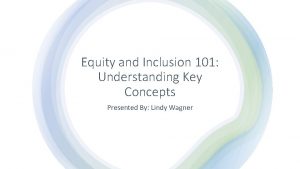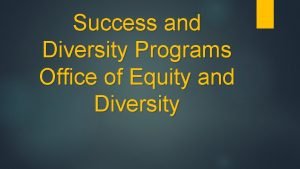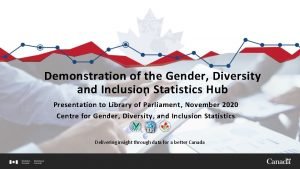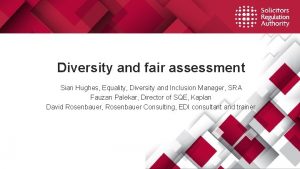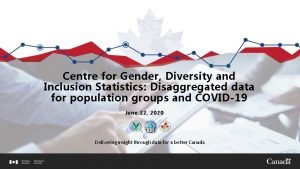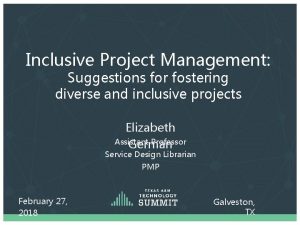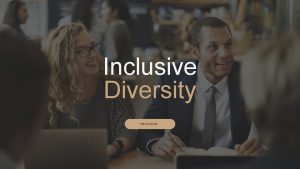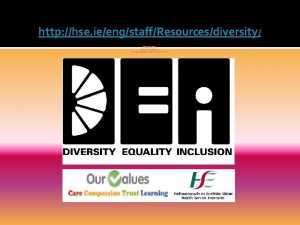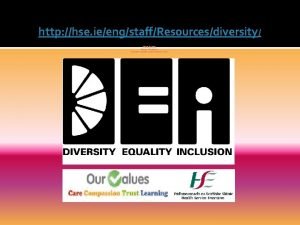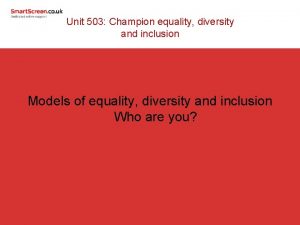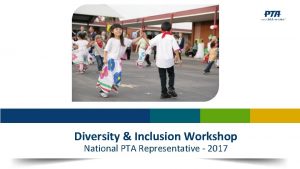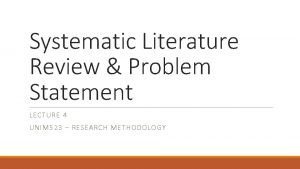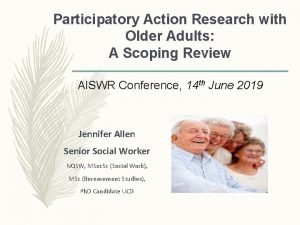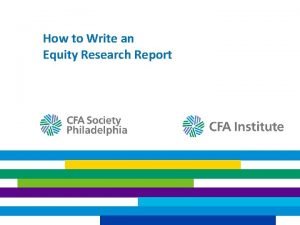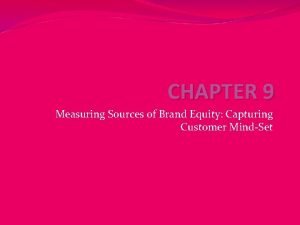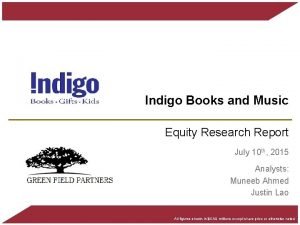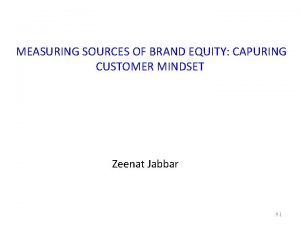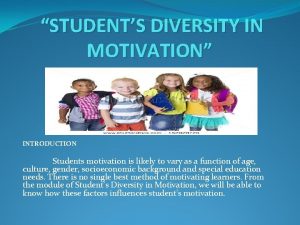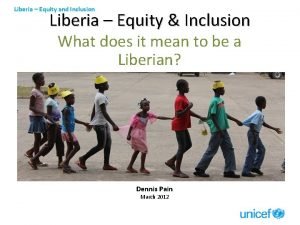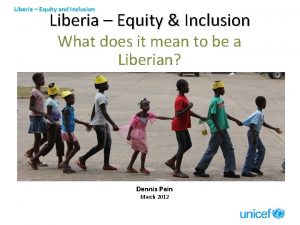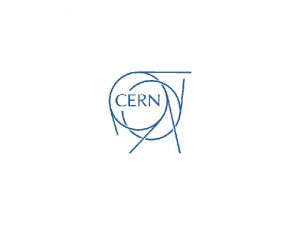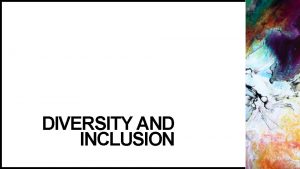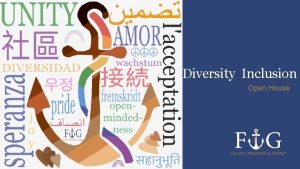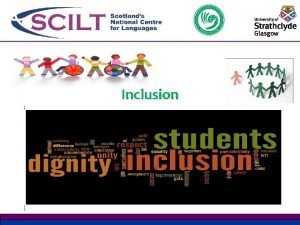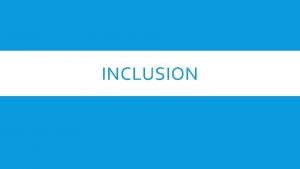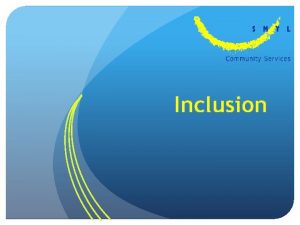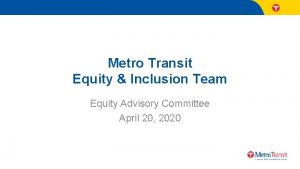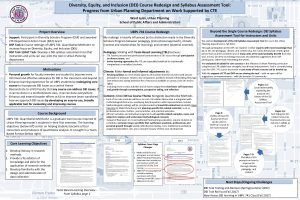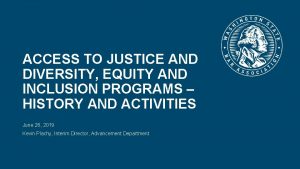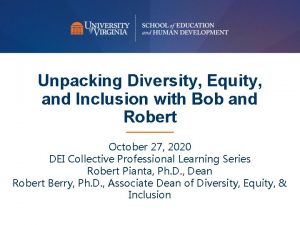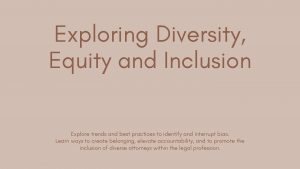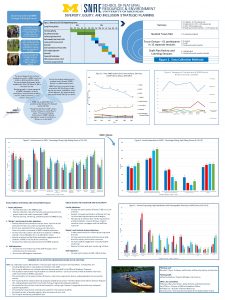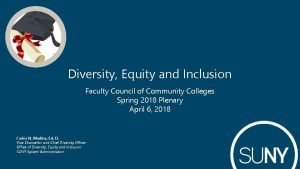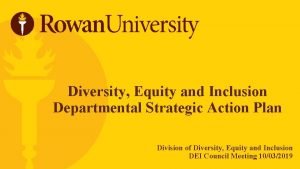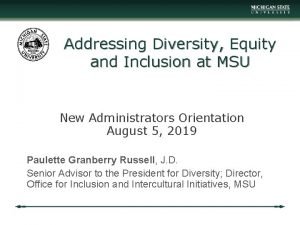Equity Diversity and Inclusion in Research Lunch and

























- Slides: 25

Equity, Diversity, and Inclusion in Research Lunch and Learn, 4 April 2019 Jacqueline Holler

Acknowledgments • I respectfully acknowledge the traditional territory of the Lheidli T’enneh, upon which we live and work.

EDI: What does it mean? 1. Equity • “Equity is the fair and respectful treatment of all people and involves the creation of opportunities and reduction of disparities in opportunities and outcomes for diverse communities. It also acknowledges that these disparities are rooted in historical and contemporary injustices and disadvantages. ”

2. Diversity • “Diversity is the demographic mix of the university community and involves recognizing and respecting everyone’s unique qualities and attributes, but focuses particularly on groups that remain underrepresented at U of T. ”

3. Inclusion • “Inclusion means creating an environment where everyone feels welcome and respected, focusing on groups that remain underrepresented at U of T. It means creating the conditions to have the opportunity to fully participate in the University, and where everyone’s talents are valued and celebrated. It is important to note that while an inclusive group is by definition diverse, a diverse group is not always inclusive. An inclusive University strives for equity, and respects, accepts and values difference. ” • University of Toronto Equity and Diversity in Research & Innovation Working Group Report (2018)

Why EDI? Why now? • Fairness, ethics, and legal obligation • CAUT 2003 Human Rights complaint re CRC program; settlement requires targetsetting; case reopened 2016, resulting in new EDI plans • TRC Calls to Action and university indigenization plans • Better research outcomes

Employment Equity: The Canadian Background • developed by 1984 Abella Commission, chaired by Justice Rosalie Abella • Enshrined by 1986 Employment Equity Act (federal employees); and 1995 Employment Equity Act (S. C. 1995, c. 44; general) • Four groups defined as “equity-seeking”: Aboriginal people, people with disabilities, “visible minorities, ” and women • complemented(anti-discrimination) by Canadian Human Rights Act

Justice Rosalie Abella, 1984 • “Ignoring differences and refusing to accommodate them is a denial of equal access and opportunity. It is discrimination. To reduce discrimination, we must create and maintain barrier-free environments so that individuals can have genuine access free from arbitrary obstructions to demonstrate and exercise fully their potential. ”

Equity Equality • “The removal of barriers to full participation by all members of the academy, regardless of gender or gender identity, physical ability, or Aboriginal or racialized status (i. e. , membership in equity-seeking groups). ” • a commitment to full representation (the idea that the academy should look like the rest of society, with diverse groups and perspectives represented)

EDI versus Employment Equity • EDI initiatives extend beyond EE “designated groups” to include, e. g. , LGBTQ+ people • EDI rooted in local realities (e. g. , GTA or NBC) as well as national context • Removal of barriers and fostering of inclusion

Barriers and systemic discrimination • “the creation, perpetuation, or reinforcement of patterns of inequality among disadvantaged groups” • “usually the result of seemingly neutral legislation, policies, procedures, practices, or organizational structures” • Creates ”barriers to full participation in society, including barriers to employment, benefits, and services, as well as barriers in the physical environment. ” • Source: Canadian Human Rights Commission

Underrepresentation: An incomplete picture Group Pop. % Workforce % University teachers % Women 50. 6 48 40 Racialized P 19. 1 24. 4 21. 1 Pw. D 13. 7 6. 7 (? ) 1 (? ) Aboriginal P 4. 3 3. 8 1. 4 LGBTQ@S P 1. 7— 5 (? ) ? ? Source: Canadian Association of University Teachers • NOTE: These data conceal inequities such as the overrepresentation of women in CAS positions that may not permit them to do funded (or any) research

Underrepresentation and the next research generation • Representation is even more an issue considering the diversity of the next generation of researchers Source: CAUT (2018), Underrepresented and underpaid

Key barriers to EDI in hiring • At hiring: committees tend to reproduce themselves, using measures of excellence that appear neutral and remaining unaware of unconscious bias (their own and others’) • E. g. , reference letter study (Dutt et al. , 2016): analysis of 1, 224 international recommendation letters, submitted by recommenders from 54 countries, for postdoctoral fellowships in the geosciences over the period 2007– 2012. Female applicants: • half as likely to receive excellent letters versus good letters compared to male applicants • evaluated less favourably by both male and female recommenders

Key barriers to EDI in researcher career progression • Valuation and reproduction of particular forms of pedagogy, research transmission, and all forms of knowledge practice • Members of equity-seeking groups appear to delay seeking promotion for fear of discrimination • Researchers from equity-seeking group receive less merit • Experimental data show that merit-system condition produces differential (discriminatory) pay • In ambiguous situations (merit review, granting assessment, etc. ), we fall back on stereotypes, which can serve as an “unconscious navigating system” (Lauren Rivera, Pedigree)

Key EDI issues in North American universities • Unconscious bias, incl. in faculty evaluation instruments: • reference letters (AAUW, 2010; Trix & Psenka, 2003; Schmader et al. , , 2007; Dutt et al. , 2016) • student surveys of teaching (Mac. Neil et al. , 2014 and many more) • • Wage inequality (and “snowballing penalty” [Woodhams et al. , 2015 & 2016]) Harassment and sexual violence Respectful workplace policies/civility codes Childcare Race/ism Mental health and mental injuries Indigenization Invisible labour, burnout of equity-seeking groups

EDI=better research outcomes • E. g. : lack of health information on understudied groups (often marginalized) • Researchers from group are often best situated to build trust and conduct research (representation) • Community engagement and community-based research may be required (inclusion) • Innovative research designs may be required (inclusion) • Best practice may be community-based knowledge transmission (inclusion) • Nancy Rumbaugh Whitesell (2017). Evidence and equity: Challenges in research design

EDI=better research outcomes, but…. • E. g. : lack of health information on understudied groups (often marginalized) • Researchers from group are often best situated to build trust and conduct research (representation) but may be absent from research landscape • Community engagement and community-based research may be required (inclusion) but may be undervalued and thus career-damaging to undertake • Innovative research designs may be required (inclusion) yet may be poorly understood by grant reviewers, peer reviewers, and tenure committees • Best practice may be community-based knowledge transmission (inclusion) but this may not be valued

What would EDI in research at UNBC look like? 1. We would know who we are (Self-study, self-ID, knowledge about representation) 2. We would have an evidence-based understanding of where we are succeeding in inclusion and where barriers remain 3. We would have a plan to address shortcomings in areas of underrepresentation 4. We would value and celebrate diverse forms of knowledge, research designs, and modes of transmission 5. We would incorporate EDI into our definitions of excellence

Thank you~ Questions/comments? • holler@unbc. ca

Key concepts in EDI: privilege • Mc. Intosh (1988), “White Privilege and Male Privilege: A Personal Account of Coming to See Correspondences through Work in Women’s Studies” • “I asked myself, On a daily basis, what do I have that I didn’t earn? It was like a prayer. The first one I thought of was: I can, if I wish, arrange to be in the company of people of my race most of the time. ” –Mc. Intosh, 2014

Key concepts in EDI: Human Rights Legislation • Canada Human Rights Act (1977) • Enforced by Canadian Human Rights Commission and Canadian Human Rights Tribunals • Applies only to federally regulated activities • Wider protected grounds than provincial legislation • BC Human Rights Code (1973) • Current protected grounds: “race, colour, ancestry, place of origin, religion, marital status, family status, physical or mental disability, sexual orientation, gender identity or expression, or age of that person or that group or class of persons. ” • Exception: BFOR, certain sex/age exemptions

Key concepts in EDI: Accommodation • Key concept for equity (as opposed to equality): • =different treatment in order to avoid discrimination • obligation to accommodate (employees and the public) to the point of undue hardship (also links to BFOR) • Undue hardship lacks precise definition but, e. g. , extreme cost, risk to others • In employment, employer has obligation to investigate need for accommodation even if not requested (e. g. , performance issue may indicate)

Key concepts in EDI: language matters • Language carries historical baggage; has power The issue of who gets to name is important • Overtly hateful and discriminatory language is less common today, but cloaked discriminatory language is still with us • Three key concepts: • Avoid unnecessary reference to group identities or characteristics • Self-identification and respect for it • People-first language • Thomas & Hirsch, A Progressive Style Guide (Sum of Us, 2016)

Key concepts in EDI: myth-busting • • “Employment equity and affirmative action are the same thing. ” means quotas. ” is reverse discrimination. ” means hiring less qualified people. ”
 Diversity equity and inclusion 101
Diversity equity and inclusion 101 Etsu equity and inclusion conference
Etsu equity and inclusion conference Diversity and inclusion scorecard
Diversity and inclusion scorecard Centre for gender diversity and inclusion statistics
Centre for gender diversity and inclusion statistics Diversity and inclusion consulting
Diversity and inclusion consulting Centre for gender diversity and inclusion statistics
Centre for gender diversity and inclusion statistics Korn ferry d&i maturity model
Korn ferry d&i maturity model Diversity training objectives
Diversity training objectives Dei pulse survey
Dei pulse survey Hse diversity equality and inclusion strategy
Hse diversity equality and inclusion strategy Mona talents priority
Mona talents priority Unit 503
Unit 503 Pta diversity and inclusion
Pta diversity and inclusion Problem statement example
Problem statement example What is the inclusion and exclusion criteria in research
What is the inclusion and exclusion criteria in research What is ecosystem biodiversity
What is ecosystem biodiversity Ecosystem jigsaw activity
Ecosystem jigsaw activity Inclusion criteria in research example
Inclusion criteria in research example Inclusion criteria in research example
Inclusion criteria in research example How to write an equity research report
How to write an equity research report Qualitative research techniques to measure brand equity
Qualitative research techniques to measure brand equity Equity research books
Equity research books Capturing customer mindset
Capturing customer mindset Research findings on student diversity on motivation
Research findings on student diversity on motivation Narrative review vs systematic review
Narrative review vs systematic review California map to inclusion and belonging
California map to inclusion and belonging
